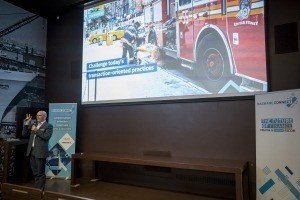
'Stop focusing on the transaction process itself and start predicting transactions,' Lauri Palokangas said during at Basware Connect Solutions in Rotterdam on May 16, 2019. 'The question, however, is how to connect people with technology. After all, an IT tool won't solve anything if people don't embrace it.'
The old headquarters of the Rotterdamse Droogdok Maatschappij was the setting for the customer day, which Basware organizes annually with partners ICreative and Ricoh. During the opening keynote, Basware's Lauri Palokangas outlined a future perspective. The way we can use intelligent technology to make decisions was discussed and with it the relationship between humans and machines.
The rise of robots and software makes it possible to automate most repetitive tasks. Automation is unbundling many occupations from past decades. As technology does all the repetitive work, skilled workers must reinvent their positions in the digital age. 'Work that used to take a week can now be done in a day. We are moving toward managing exceptions,' Palokangas said. 'What are you going to do later with that extra time?'
Illegal conversions in New York
 The future perspective Palokangas outlined toward the participants was that they should become forecasters. Using the city of New York as an example, he illustrated how that works in practice. "New York means so many things to so many people, but almost no one thinks about how it gets its electricity," Palokangas noted. In this context, New York suffers from so-called illegal conversions, or the practice of dividing a house into much smaller units so that the house can accommodate as many as 10 times as many people as it was designed for.
The future perspective Palokangas outlined toward the participants was that they should become forecasters. Using the city of New York as an example, he illustrated how that works in practice. "New York means so many things to so many people, but almost no one thinks about how it gets its electricity," Palokangas noted. In this context, New York suffers from so-called illegal conversions, or the practice of dividing a house into much smaller units so that the house can accommodate as many as 10 times as many people as it was designed for.
The problem with this is that fire hazards lurk. A tangle of extension cords and hot plates on top of bedspreads cause numerous fires, and it is not unusual for deaths to occur here. In 2005, two firefighters even died trying to rescue residents. New York gets about 25,000 complaints about illegal conversion each year, but has only 200 inspectors to handle them.
New way of problem solving
 At the time, then-Mayor of New York Michael Bloomberg appointed Mike Flowers as the city's first director of analytics to address the problem of illegal conversions. Flowers solved the problem with data. 'He used data to predict where and when fires would break out. To arrive at predictions, he did not want experienced statisticians because he feared they would be reluctant to his new way of problem solving. So he plucked five college students for his team.'
At the time, then-Mayor of New York Michael Bloomberg appointed Mike Flowers as the city's first director of analytics to address the problem of illegal conversions. Flowers solved the problem with data. 'He used data to predict where and when fires would break out. To arrive at predictions, he did not want experienced statisticians because he feared they would be reluctant to his new way of problem solving. So he plucked five college students for his team.'
Finance people can also use the new technology to become predictors and make better decisions. 'For example, you can improve your payment performance by predicting which invoices will be paid late in the future, see which spend categories are expected to be the largest, or identify a future liquidity problem at your supplier,' Palokangas illustrated.
'However, an IT tool won't help if people don't embrace it. Therefore, we need to train people to think differently. Connecting people with technology means that people need to start thinking in tasks in order to take advantage of analytics and Artificial Intelligence," Palokangas said.







